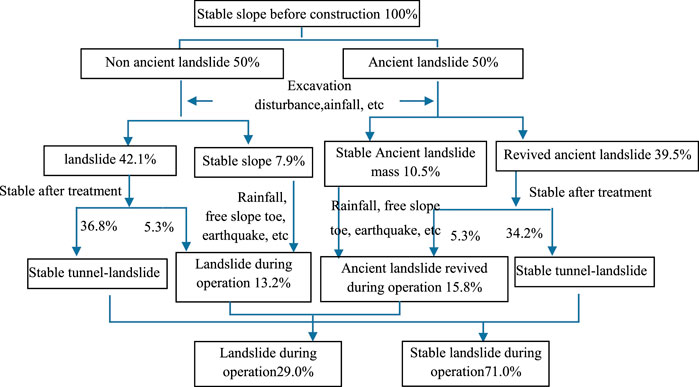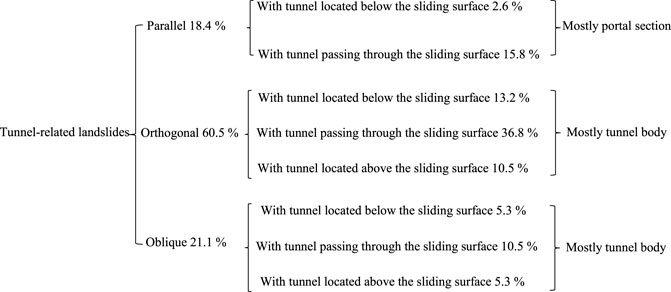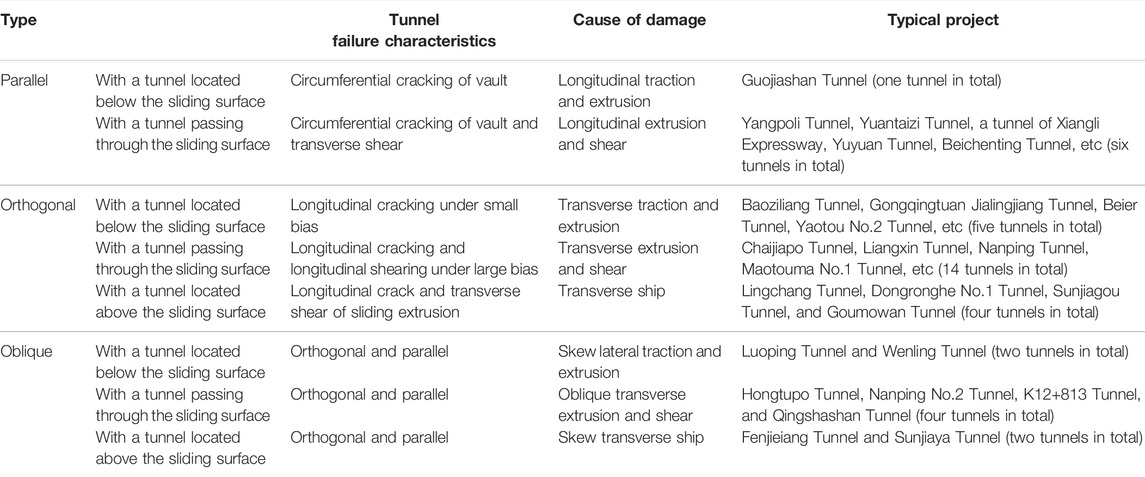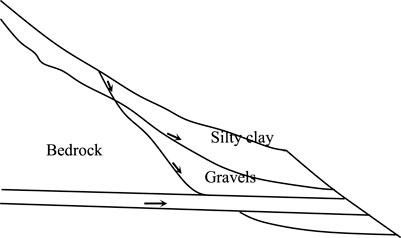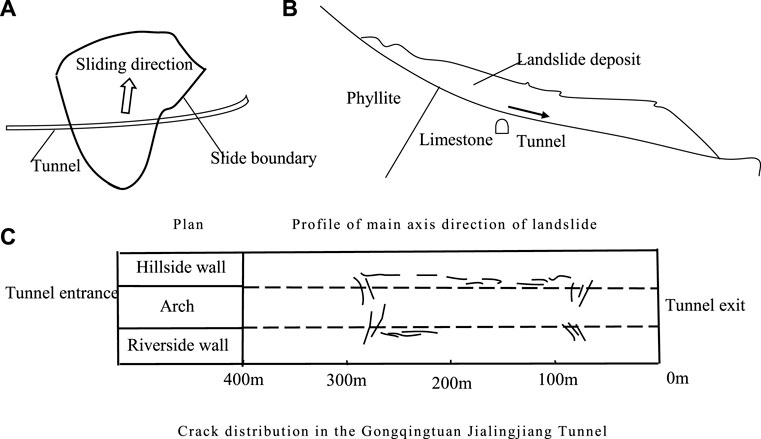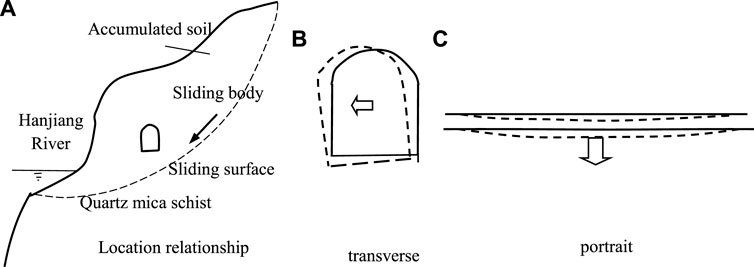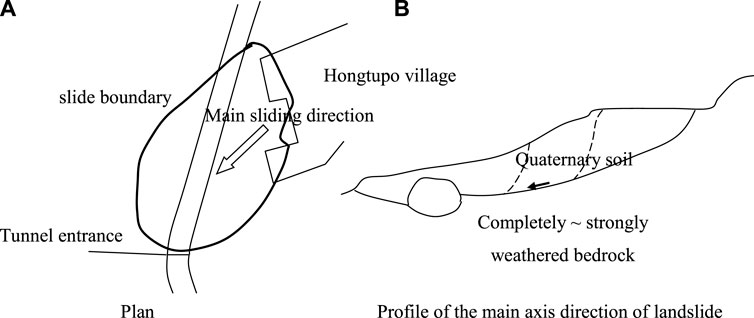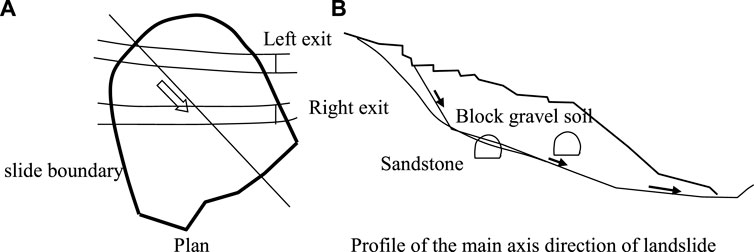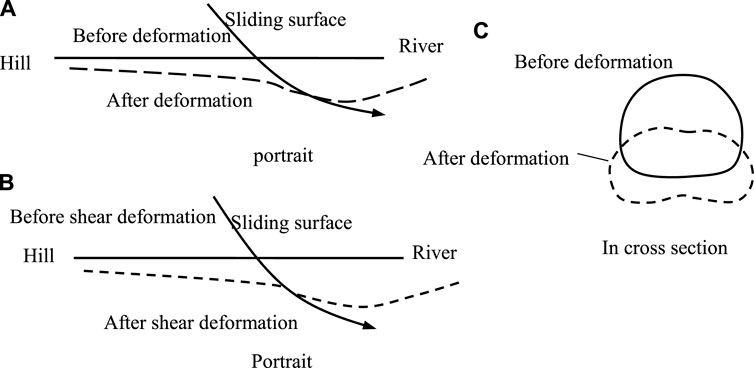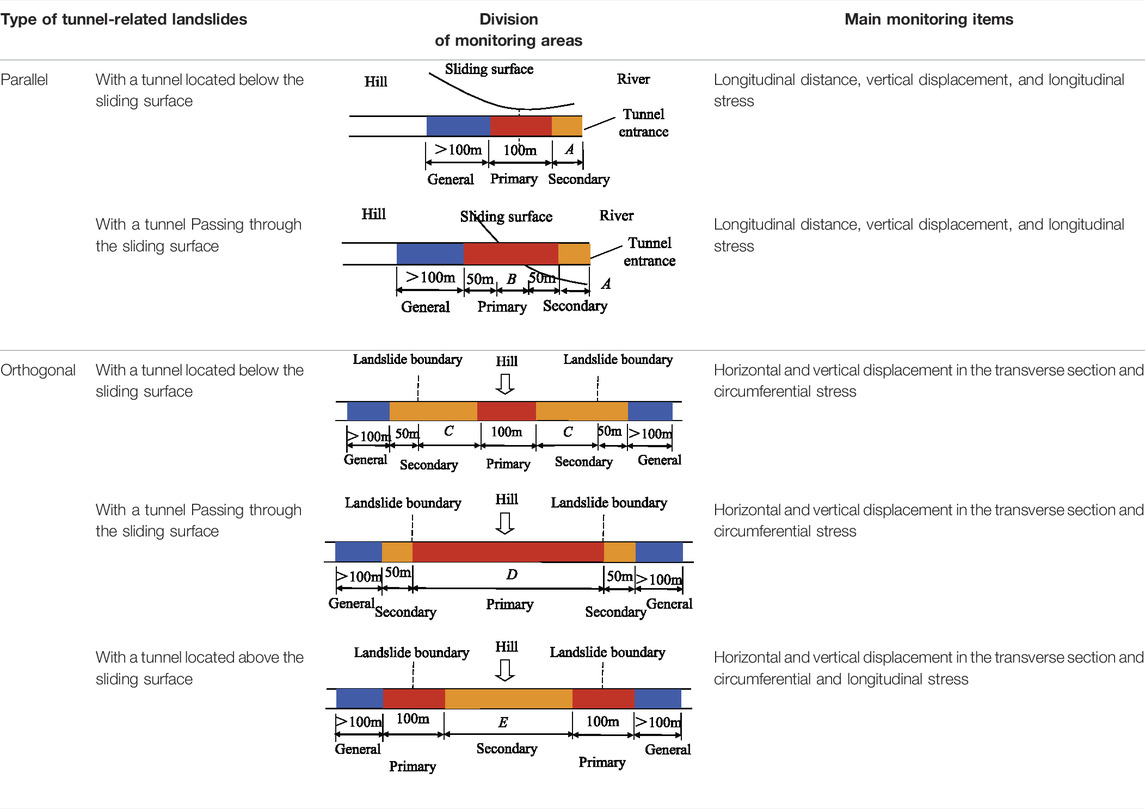Deformation and Failure Mode Analysis of the Tunnel Structure Based on the Tunnel-Related Landslides Cases
- 1State Key Laboratory of Mechanical Behavior and System Safety of Traffic Engineering Structures, Shijiazhuang Tiedao University, Shijiazhuang, China
- 2Key Laboratory of Roads and Railway Engineering Safety Control (Shijiazhuang Tiedao University), Ministry of Education, Shijiazhuang, China
- 3Hebei Province Technical Innovation Center of Safe and Effective Mining of Metal Mines, Shijiazhuang, China
When the tunnel passes through the slope area, once the slope stability changes or landslide disasters occur, large additional stress, deformation, or cracking are easily caused in the tunnel, which results in high risk to the tunnel operation. The deformation and failure mode of the tunnel induced by different types of tunnel-related landslides are different. However, there is no systematic classification of tunnel structure deformation and the failure mode in the tunnel-related landslides systems. By investigating the typical cases of tunnel diseases caused by landslide in China, this study analyzes the relationship between the tunnel-related landslide types and tunnel disease characteristics. It also summarizes five typical tunnel deformation failure modes and corresponding deformation characteristics and determines the relationship between tunnel-related landslide types and deformation failure modes. This study can provide a technical support for the identification of landslide types through the tunnel deformation characteristics in practical engineering applications. Finally, it provides a reference for tunnel location selection, the design of tunnel structure, and the treatment of landslide in landslide areas.
1 Introduction
Landslide or rock collapse are the main types of geological disasters in slope areas, which often obstructs traffic, destroys the village, or causes casualties. Many researchers have studied the causes, development patterns, and control measures of landslides and rock collapse (Ma and Wu, 2011; Yang et al., 2016; Du et al., 2021). Based on the study on the causal mechanism and early warning of rock collapse disasters, Du et al. (2021) deduced that the quantitative identification and fuzzy evaluation of rock bridges is the key to the early warning and prevention of rock collapse disasters in the future. Based on the latest study and survey results, Du et al. (2020) studied the cause of translational landslides, built a corresponding model, and validated the reliability of the genetic mechanism using case studies. They deduced that increasing the total stress caused by a higher water level is one of the main reasons for translational landslides. A large number of engineering practices proved that the landslide occurs or the ancient landslide is revived due to natural and human factors (Wang et al., 2020). When the relative position relationship between the tunnel and the landslide is unfavorable, the landslides often cause additional stress and deformation of the tunnel structure in the slope section. In some cases, serious diseases occurred on the structure, such as cracking and falling blocks, which endanger the operation safety. This type of landslides which can bring risk to the tunnel is referred to as tunnel-related landslides. All of them are collectively referred to as the tunnel-related landslides system.
In fact, it is necessary to perform an in-depth study in tunnel diseases in the landslide region. For instance, Ma (2003) and Ma and Wu (2016) developed six geological structure modes of tunnel deformation in a typical slope disease section. They also summarized the characteristics of tunnel deformation under the action of landslide, raise corresponding technical measures for the prevention and control by performing inductive analysis on documents of tunnel deformation, and cracking in the slope disease section using field test methods. In addition, they performed large-scale model test and numerical simulation based on the investigation and study on living examples of tunnel deformation in the slope disease section from 1980s. Zhou et al. (2002) summarized five geological structure models and four characteristics of tunnel deformation in slope disease section, based on the analysis of the characteristics of tunnel deformation and cracking, as well as the relationship between deformation and cracking. Tao, (2003) and Tao and Zhou (2003) demonstrated that the relative position relationship between the tunnel and the sliding surface is the main factor determining the characteristics of tunnel deformation. A total of four geomechanical models were then developed to analyze the interrelation between landslide and tunnel deformation. Moreover, the stress mode of tunnel under different relative position relations was analyzed. Ashtiani et al. (2010) demonstrated that the interaction between the tunnel and side slope is related to the position of the tunnel in the side slope. Based on the Jimei Tunnel in China, which orthogonally traverses a large bedrock landslide, Zhu et al. (2021) inverted the physical parameters of the landslide using a uniform design and a radial basis function neural network model. Consequently, they developed a model for the interaction between the tunnel and landslide. Furthermore, the relationship between the stability of the slope and deformation of tunnel structures was studied. Zhang et al. (2017) focused on the analytical derivation and numerical simulation analysis in order to predict the interaction influences between a landslide and a new tunnel in mountain areas. Zhang et al. (2021) proposed a simplified analytical method to evaluate the deformation of existing tunnels induced by landslides. Wu (2012) and Wu et al. (2012) divided the tunnel–landslide system into parallel, orthogonal, and oblique relations, according to the angle between the main axis of landslide and the tunnel axis. It was then classified into the tunnel inside the landslide body and the tunnel intersected with the sliding surface, based on the relative location between the tunnel and the landslide surface.
Using a field test, model test, and numerical simulation, these studies analyzed the relationship between the slope diseases and characteristics of tunnel deformation and cracking. They also developed the corresponding geological structure models and main characteristics of tunnel deformation. Finally, they demonstrated that the relative position of tunnel and landslide were the main factors determining the deformation and failure characteristics of the tunnel. However, they failed to clearly determine the deformation and failure classifications of tunnel, under the action of landslide. Moreover, they did not determine the corresponding relationship between the landslide types and tunnel deformation modes from the tunnel perspective. In fact, it is expected to determine the direct relationship between the landslide types and characteristics of tunnel deformation and failure using the case investigation of the interaction between landslide and the tunnel. Consequently, the landslide type can be analyzed, or the landslide tunnel interaction mode can be defined according to the characteristics of tunnel deformation or failure. Therefore, a basis for landslide type identification, landslide prediction, and prediction of the tunnel structure changing trend can be provided in specific projects. Moreover, targeted treatment and reinforcement of potential landslide and the tunnel can be implemented, so as to avoid further deterioration of landslide and reduce tunnel diseases. Therefore, studying the relation between tunnel-related landslides type (i.e., type of interaction between tunnels and landslides) and characteristics of tunnel diseases has a theoretical guiding significance and engineering application value.
Consequently, based on a large number of studies, almost 40 typical cases of tunnel diseases caused by landslide are considered, and types of tunnel-related landslides are sorted out. Furthermore, the corresponding landslide characteristics and tunnel diseases are assessed and analyzed. Finally, typical deformation and failure modes of tunnel are summarized.
2 Tunnel-Related Landslides Classification and Statistics
2.1 Tunnel-Related Landslides Classification
The tunnel-related landslides can be classified according to the time of occurrence. According to the construction stage (landslides occurred during tunnel construction) or the tunnels operation stage, they can be divided into landslides in the project period and landslides in the operation period.
However, the specific classification is based on the spatial location relationship between the landslide and tunnel. The different spatial relationships lead to different impacts on the tunnel such as stress, deformation, and failure characteristics. The relative positions between the tunnel and sliding surface determine the deformation form, stress characteristics, and failure law of the tunnel. In other words, they directly determine the deformation and failure mode of the tunnel. Based on the existing studies, the tunnel-related landslides are divided into three types: parallel, orthogonal, and oblique, according to the plane position (Wu et al., 2012). The parallel system refers to an angle of 0°–20° between the main sliding direction of the landslide and the axial direction of the tunnel, which are parallel or approximately parallel. According to the crossing position, they are divided into two types: with tunnel located below the sliding surface and passing through the sliding surface. The parallel system is mostly seen in the landslide on the front slope of the tunnel top at the entrance. The orthogonal system refers to an angle of 70°–90° between the main sliding direction of the landslide and the axial direction of the tunnel, that are vertical or approximately vertical. They are divided into three types: with tunnel located below the sliding surface, passing through the sliding surface, and above the sliding surface. The oblique system refers to an angle of 20°–70° between the main sliding direction of the landslide and the axial direction of the tunnel.
2.2 Tunnel-Related Landslides Statistics
2.2.1 According to the Time of Occurrence
Figure 1 presents the statistics of tunnel-related landslides cases during the operation period. In the statistical cases, 50% of the slopes are not ancient landslides and originally stable, while 50% of them are ancient landslides and stable. In addition, 81.6% of landslides occur during the engineering period. Most of them are stable after treatment. However, the landslides occur again during the operation period in 10.6% of them. Moreover, 18.4% of landslides occur during the operation period. However, the slope is stable during the construction period (10.5% of which are revived ancient landslides). The main inducing factors of landslide during the engineering period are the tunnel construction disturbance, rainfall, free face at the foot of the slope, and earthquake. The main factors of landslide during the operation period are the rainfall, free face at the foot of the slope, earthquake, and continuous influence of disturbance during the construction period.
About 29.0% of the tunnel-related landslides cases occur during the operation period. They often lead to additional deformation or damage to the tunnel structure, which brings a great threat to the safe operation of the tunnels. Furthermore, it is very difficult to make early warning, identification, and treatment of landslides.
2.2.2 According to the Relative Position
Figure 2 shows the tunnel-related landslides types according to the relative position and the proportion of different types of case investigation.
The statistical results show that the proportions of the parallel system, orthogonal forms, and oblique forms are 18.4%, 60.5%, and 21.1%, respectively. In addition, the disease tunnels are caused when the tunnel passes through the sliding surface in the 63.1% of all the cases. The landslides in the cases of the Yangpoli, Yuantaizi, Beier, Yaotou No.2, Chaijiapo, Chibanggou, Tuoping, Hongtupo, Pingzhong No. 2, and Sunjiaya tunnels, accounting for 26.3% of the total number of cases, are potential landslides in the creep stage. However, they also lead to tunnel diseases.
3 Investigation on Landslide Types and Tunnel Disease Characteristics
Based on the investigation and induction of typical engineering applications, the causes, characteristics, and typical engineering cases of tunnel failure are analyzed and summarized according to the different relative position relationships of tunnel landslide systems (cf. Table. 1).
3.1 Parallel System
3.1.1 With Tunnel Located Below the Sliding Surface
In the Guojiashan Tunnel (Wu et al., 2012) of Wudu–Guanzigou Expressway, the overlying strata of the tunnel are loose accumulation, phyllite, and metamorphic slate. The sliding surface of the landslide is located at the contact surface between the accumulation and bedrock, while the sliding body has a thickness less than 60 m. The tunnel diseases are mainly the crushing cracking of the arch crown, while the abutment dislocation occurs in serious cases. In particular, the crack width of the portal section is large and elongated. The closer it is to the entrance, the greater the deformation.
3.1.2 With Tunnel Passing Through the Sliding Surface
The typical cases include the Yangpoli Tunnel of Wudu–Guanzigou Expressway, Yuantaizi Tunnel of Wudu–Guanzigou Expressway, tunnel-landslide of Xianggelila–Lijiang Expressway, Yuyuan Tunnel and Beichenting Tunnel of Jingdezhen–Yingtan Expressway, and Lishiguan Tunnel of Shiyan–Manchuan Expressway. The slope stratum at the exit of the right line of the Yuantaizi Tunnel (Wang et al., 2012; Pai et al., 2018; Zhao, 2019) is mainly composed of gravelly soil. The shallow surface layer is silty clay having a thickness of almost 6 m. The tunnel excavation disturbance leads to the creep deformation of the slope. In addition, the sliding direction is coherent with the line direction, and the sliding surface passes through the tunnel 41 m away from the tunnel exit. The location relationship between the right entrance of the tunnel and the landslide is shown in Figure 3.
It can be seen that near the sliding surface, due to the sliding shear action of the landslide thrust, the tunnel arch is tensioned, with circumferential shear cracks and longitudinal tension cracks, serious vault subsidence, arch concrete cracking, and falling blocks.
3.2 Orthogonal System
3.2.1 With Tunnel Located Below the Sliding Surface
The typical cases include the Baoziliang Tunnel of Baoji–Zhongwei Railway, Beier Tunnel and Yaotou No.2 Tunnel of Mengzi–Xinjie Highway, New Mingyuexia Tunnel of Baoji–Chengdu Railway, and the Jialingjiang Tunnel of Gongqingtuan line. The maximum buried depth of the Gongqingtuan Jialingjiang Tunnel (Lu 2012) is almost 60 m. It passes through the middle of Nanshan ancient landslide, whose terrain is steep at the top and gentle at the bottom. The slope has a length of 300 m and a width of 250 m, while the average thickness of the accumulation layer is 25 m. The sliding body is silty clay mixed with block stone and gravel, and the sliding surface (belt) is the contact surface between the accumulation layer and limestone. The landslide is originally stable but resurrected under the joint action of local continuous rainfall and human factors. The positional relationship between the tunnel and Nanshan landslide is illustrated in Figures 4A,B.
Longitudinal and diagonal cracks appear in the tunnel. However, circumferential cracks do not exist. The cracks start at 80 m near the entrance and end at 200 m away from the exit, while the starting position coincides with the landslide boundary. At the landslide boundary, diagonal cracks (almost 45° from the longitudinal axis of the tunnel) appear in the arch foot and sidewall of the tunnel, and water seepage occurs. Longitudinal cracks appear at the foot of the arch and the sidewall of the tunnel under the sliding mass. The crack width is 5–20 mm, while the maximum length of a single crack exceeds 10 m. The cracks distribution is shown in Figure 4C.
3.2.2 With Tunnel Located Passing Through the Sliding Surface
The typical cases include the Nanping Tunnel of Datong–Zhungeer Railway, Maotouma 1# Tunnel of Chengdu–Kunming Railway, Bozicun No.1 Tunnel of Nanning–Kunming Railway, Chahe Tunnel of Kunming–Dongchuan Railway, Chuanzhusi Tunnel of G213 Line of National Highway, Liupo No.1 Tunnel of a Highway, Dayuan No.1 Tunnel of Lechuan–Guangzhou Expressway, Chaijiapo Tunnel of Xiangyang–Chongqing Railway, Liangxin Extra Long Tunnel of Huxian–Mianxian Expressway, Chibanggou Tunne of Shenmu–Yan’an Railway, Gutian Tunnel of Ganzhou–Longyan Railway, Dayangtan Tunnel of Naxi–Xuyong Railway, railway tunnel ancient landslide, and Qigangou Tunnel of Xiangyang–Chongqing Railway. The crossing stratum of the Nanping Tunnel (Kong 2017; Luo et al., 2018; Wang 2018) is mainly quaternary Q3 loess, artificial fill, Upper Permian sandstone, and sandstone. During the tunnel operation, cracks in the sidewalls and partial water seepage are observed with a rapid development.
The position relationship of landslide in the Nanping Tunnel is illustrated in Figure 5. The angle between the main direction of landslide and longitudinal direction of the tunnel is 87°, while the sliding surface intersects at the sidewall of the tunnel. The sliding body is mainly composed of loess, artificial filling, completely weathered sandstone, and mudstone, having a thickness of 17–43 m. The slide zone is mainly interbedded between strongly weathered sandstone and mudstone having a thickness of 0.5–1.0 m. The water content of rock and soil in the slide zone is high, and the rock mass is clearly wrinkled.
It can be seen that the tunnel is seriously damaged by landslide such as lining cracking, water leakage, swelling, and uplift of ditch. In addition, staggered abutment of construction joint occurs in the tunnel. The cracks are mainly in the longitudinal direction, distributed in the left and right sidewalls of the tunnel. More precisely, there are five longitudinal through cracks between No. 14–18 Avoidance Tunnel on the side of the hill, with an extension of 75 m and a width of 3–5 mm. The circumferential cracks are relatively few and mainly located near the construction cracks, while few diagonal cracks exist. Several staggered construction joints exist at the sidewall of the tunnel, and the maximum staggered platform is 5 cm.
3.2.3 With Tunnel Located Above the Sliding Surface
The typical cases include the Linchang Tunnel of Chengdu–Kunming Railway, Dongronghe No. 1 Tunnel of Chengdu–Kunming Railway, Sunjiagou Tunne of Linxian–Lishi Expressway in Shanxi Province, and Goummowan Tunnel of Hunan–Chongqing Railway. During the Goumowan Tunnel (Zhao, 2019) construction, the slope body slides due to continuous rainfall. The landslide is mainly the sliding of accumulated soil along the underlying quartz mica schist, with a sliding surface having a depth of 80 m on the main shaft section. The location relationship between the tunnel and landslide is presented in Figure 6A.
The tunnel deformation is mainly based on the overall river side displacement and longitudinal bending, in which the overall movement to the Hanjiang River is 0.079–0.299 m. Staggered platforms exist in local locations. In addition, transverse annular cracks appear in the sidewalls. Few longitudinal cracks and distortions occur in the expansion joints. Figures 6B,C show the tunnel deformation characteristics.
3.3 Oblique System
3.3.1 With Tunnel Located Below the Sliding Surface
The typical cases include the Luoping Tunnel of an expressway and Wenling Tunnel of Daying–Shenchi Expressway. The relative position relationship between the Wenling Tunnel (Deng 2014; Li 2017) and landslide at the entrance is illustrated in Figure 7. During the tunnel construction, the excavation at the bottom of the slope results in the free face, which is not timely supported. In addition, the infiltration of rainwater softens the soil–rock interface. Eventually, the tunnel construction and rainwater induce the sliding of the overburden with a thickness of 6–10 m. In addition, the tunnel direction is diagonally intersected with the sliding direction. The sliding mass causes crushing and cracking of the cover arch at the tunnel exit.
3.3.2 With Tunnel Passing Through the Sliding Surface
The typical cases include the Hongtupo Tunnel (Deng and Zhang, 2005) of Xianglin Expressway, Pingzhong No.2 Tunnel on Nanning–Kunming Railway, K12+813 Tunnel of an expressway in southwest mountainous area, and Qingshashan Tunnel of Pingan–A’Dai Expressway. The location relationship between the Hongtupo Tunnel and landslide is illustrated in Figure 8. It can be seen that the landslide is in the stage of creep deformation. The sliding body has a thickness of 10–17 m. The main sliding direction obliquely intersects with the axis of the tunnel (angle of 40°), and the sliding surface intersects with the tunnel at the sidewall. The tunnel leads to severe bias pressure, structural deformation, and cracking. The deformation is mainly the settlement of the arch crown and the clear shear displacement of the arch ring above the camber line, in which the tunnel structure above the camber line displaces about 2 cm to the river side.
3.3.3 With Tunnel Located Above the Sliding Surface
The typical cases include Fenjieliang Tunnel of Chongqing–Yichang Expressway and Sunjiaya Tunnel of Fengjie–Wuxi Expressway in Chongqing. The entrance of Fenjieliang Tunnel is located in an ancient landslide with an average thickness of 18 m. The entrance of the left-line tunnel goes through the slip zone, while the body of the right-line tunnel is all within the accumulation of ancient landslide. The relationship between the Fenjieliang Tunnel and the ancient landslide is illustrated in Figure 9.
The ancient landslide is revived by tunnel construction and heavy rainfall. Affected by the landslide, the right-line tunnel is mainly displaced as a whole. In addition, tension cracks appear at the sidewall and arch foot against the mountain. These cracks appear outside the expansion joints in a staggered manner. Longitudinal cracks having a width of almost 1–5 mm exist near the right side of the arch of the left-line tunnel. The extension length is almost 10 m, and the overall movement is not clearly observed.
4 Tunnel-Related Landslides Deformation Mode
When the tunnel-related landslide is an oblique system, the stress and deformation characteristics can be considered as the combination of parallel and orthogonal systems. Therefore, this study only analyzes the deformation mode of the tunnel-related landslide in parallel and orthogonal forms.
4.1 “Longitudinal Pull” Mode
For the parallel form of tunnel-related landslides, when the tunnel is located below the slide surface, the sliding mass causes an action of “oblique pull” on the surrounding rock and tunnel, that are below the sliding surface. This pull action can be divided into longitudinal and vertical actions, which results in longitudinal (along the axial direction of the tunnel) deformation and subsidence of the tunnel arch, as well as circumferential cracking of the arch crown in serious cases. The displacement of the tunnel is mainly manifested as “longitudinal deformation and sinking in the transverse section.” The effect of “Longitudinal pull” is gradually decreased when the distance increases between the sliding surface and the tunnel. The deformation form is illustrated in Figure 10.
4.2 “Longitudinal Shear” Mode
For the parallel form of tunnel-related landslides, when the tunnel goes through the sliding surface and only the entrance of the tunnel is located in the landslide body, the tunnel can be approximated by a cantilever beam structure, and it is directly subjected to the action of “longitudinal extrusion and shear forces.” That is, besides the pressure of surrounding rock on the transverse section, the tunnel structure is also directly subjected to the action of the landslide’s longitudinal thrust, which can be divided into longitudinal and vertical load components of the tunnel. Sinking, tensile deformation and bending deformation longitudinally exist along the tunnel. Moreover, the tunnel structure near the slide surface may have circular cracks in the vault or shear cracks along the sliding direction, which can lead the tunnel to shear and misalign in serious cases. The displacement of the tunnel is mainly manifested as “longitudinal displacement and staggered sinking.” The deformation scheme is presented in Figure 11.
4.3 “Transverse Pull” Mode
For the orthogonal form of tunnel-related landslides, when the tunnel is located below the slide surface, the sliding of the slip mass produces a “horizontal pull” on the tunnel. This pull can be divided into horizontal and vertical action. This action can be divided into lateral and vertical actions. The tunnel bears small bias load. Therefore, the arch deflects towards the river side, and longitudinal cracks appear in some serious cases. The tunnel displacement mainly occurs in the transverse section, and a “small deflection displacement” exists in the cross section (cf. Figure 12). Simultaneously, this pulls effect of the slip mass on the tunnel is gradually weakened with the increase of the vertical distance between the tunnel and sliding surface.
4.4 “Transverse Shear” Mode
For the orthogonal form of tunnel-related landslides, when the tunnel goes through the slide surface with its lower part located in the sliding bed and upper part in the sliding mass, the tunnel lining in the sliding mass is subjected to the landslide thrust. The tunnel will then be put in shear and bear large bias load. The tunnel structure will be “sheared off” if it cannot stop the sliding mass, which forms longitudinal cracks and longitudinal shear under large bias load as well as large deflection (tilt) displacement of the cross section around the bottom of the wall. The tunnel displacement is mainly manifested in the transverse section, with a “large deflection displacement” in the cross section (cf. Figure 13).
4.5 “Transverse Ship” Mode
For the orthogonal form of tunnel-related landslides, when the tunnel is located above the sliding surface, the tunnel inside the sliding body slides with it, and a longitudinal bending occurs under the landslide thrust. The tunnel structure near the boundary of the sliding body will be in a shear state, and it will be transversely sheared in serious cases. After shearing, the tunnel displacement is dominated by the overall outward displacement, which is commonly known as “lateral translation motion.” The tunnel displacement is mainly within the traverse section. In addition, a “misalignment translation” exists in the cross section. The deformation is illustrated in Figure 14.
5 Discussion
The geological environment is weak in Sichuan–Tibet Plateau, China, and the mountain disasters are extremely serious. Landslides, collapses and rockfalls frequently occur due to rock freezing and thawing damage (Li et al., 2022; Zhang et al., 2022). After the development of the Sichuan–Tibet Railway project, many key technical problems should be urgently solved. Firstly, a decent choice of the tunnel location in landslide area is crucial. In addition, the quick identification of the landslide type and its relative position with the tunnel is essential.
1) Even if the tunnel is located below the sliding surface, the landslide may cause its deformation or destruction. In these investigated cases, the maximum vertical distance between the sliding surface and the tunnel is 20 m, while 90% of them occur within 10 m. Therefore, the safe vertical distance between the sliding surface and the tunnel is greater than 20 m. Therefore, when the tunnel passes through the slope section, the stability analysis of the slope body, especially the ancient landslide body, should be performed based on geological survey, and the ancient slide surface or potential landslide surface should be found. Afterward, when determining the location of the tunnel, the best plan for the tunnel is to pass through the landslide more than 20 m below the sliding surface.
2) During the construction of the tunnel which passes through the landslide area, many displacement monitoring sections should be arranged along its axial direction. If the automatic data acquisition system is equipped, automatic monitoring of three-dimensional structure displacement can be performed in the whole process of tunnel construction and operation. The plane position relationship between the tunnel and the main slip direction can be determined by analyzing the angle between the horizontal displacement direction and the tunnel axial direction. A further analysis can be performed on the distribution rules of displacement of each monitoring point along the tunnel longitudinal direction and in the cross section. The vertical position relationship between the tunnel and the sliding surface can be determined according to the deformation diagram of different modes presented in Section 4. In addition, the development trend of landslide can be predicted by analyzing the displacement-time relationship curve of each monitoring point.
3) The safety of the tunnel structure should be guaranteed with minimal monitoring. Therefore, according to the analysis presented in Sections 3, 4, the monitoring items of tunnels with different tunnel landslide types are determined. At the same time, the tunnel is divided into several monitoring areas according to the importance, and different monitoring section spacing is set for different areas. Table 2 shows the division of monitoring areas and main monitoring items. Table 3 presents the recommended distance between monitoring sections.
6 Conclusion
In this study, the characteristics of tunnel deformation and diseases with different relative positions of sliding zone are analyzed by investigating and summarizing typical cases of tunnel-related landslides. The following conclusions are drawn.
1) Based on the investigations and statistics of typical cases, it can be concluded that most of the landslides occurred during the engineering period. They are mainly triggered by the disturbance of tunnel construction, rainfall, dangling bottom of slope and earthquake. Only 29% of tunnel-related landslides occurred during the operation period, which resulted in the greater deformation or damage to the tunnel structure, in which it is extremely difficult to retreat. The main factors of landslides are the rainfall, dangling bottom of slope, earthquake, and continuous influence of construction disturbance. In addition, although the ancient landslides are usually identified and analyzed for stability during the tunnel location selection, the proportion of revival ancient landslides is 50%.
2) The relative position relationship between the tunnel and landslide determines the deformation form and failure characteristics of the tunnel, which can be used for the classification of tunnel-related landslides. Based on the plane relationship between the tunnel and sliding surface, the tunnel-related landslides are divided into three types: parallel, orthogonal and oblique. According to the crossing position, the landslides are divided into three types: with tunnel located below the sliding surface, passing through the sliding surface and above the sliding surface. According to the statistical results, most of the disease cases are caused by the orthogonal form, which accounts for 60.5% of the total cases, followed by the oblique form. In addition, compared with tunnels under or above the sliding surface, they are more susceptible to diseases when passing through the sliding surface. These cases account for 63.1% of the total. Moreover, the tunnels under the sliding surface have fewer diseases.
3) According to the investigation and analysis of the tunnel-related landslides disease characteristics, corresponding tunnel deformation modes are summarized and developed based on the classification of the tunnel-related landslide. They are divided into five basic modes: longitudinal pull, longitudinal shear, transverse pull, transverse shear, and transverse ship. These deformation modes can explain the deformation characteristics of the tunnels with different relative positions. They can also provide a theoretical basis for studying slope diseases, tunnel destruction and diseases.
4) Based on the comprehensive analysis of interaction mechanism between the landslide and tunnel on deformation modes, five corresponding tunnel deformation characteristics are summarized: longitudinal deformation and sinking, longitudinal deformation and staggered sinking, small deflection displacement of section, large deflection of section, and cross section misalignment translation. Finally, the results of this study can provide a comparative basis for tunnel authorities to determine the location of the tunnel and identify landslide hazard types by tunnel deformation characteristics.
Author Contributions
SM and ZY were responsible for the whole study; LHo and LHu were responsible for data collection; SM and ZY were responsible for drafting the manuscript; GX and ZZ were responsible for making important revisions to the manuscript; SM and GX were responsible for approving the final version of the manuscript for publication.
Funding
This work was supported by the National Natural Science Foundation of China under Grant No. 52178391, and the State Key Laboratory of Mechanical Behavior and System Safety of Traffic Engineering Structures under Grant No. ZZ 2021-09.
Conflict of Interest
The authors declare that the research was conducted in the absence of any commercial or financial relationships that could be construed as a potential conflict of interest.
Publisher’s Note
All claims expressed in this article are solely those of the authors and do not necessarily represent those of their affiliated organizations, or those of the publisher, the editors, and the reviewers. Any product that may be evaluated in this article, or claim that may be made by its manufacturer, is not guaranteed or endorsed by the publisher.
References
Ashtiani, M., Palassi, M., and Ahmadi, A. (2010). Effect of Excavation of Tunnels in the Convex Slopes Using Distinct Element Method. International Society for Rock Mechanics.
Deng, X. (2014). Analysis and Comprehensive Treatment of Landslide for Wenling Tunnel. Highway 59 (05), 119–122.
Deng, X., and Zhang, X. (2005). Cause of Deformation and Reinforced Methods of Hongtupo Tunnel on Xiang-lin(Xianyun-Lincang) Highway in Yunnan Province. Chin. J. Geol. hazards Prev. 16 (02), 74–79. doi:10.16031/j.cnki.issn.1003-8035.2005.02.016
Du, Y., Xie, M., and Jia, J. (2020). Stepped Settlement: A Possible Mechanism for Translational Landslides. Catena 187, 104365. doi:10.1016/j.catena.2019.104365
Du, Y., Xie, M., Jiang, Y., Chen, C., Jia, B., and Huo, L. (2021). Review on the Formation Mechanism and Early Warning of Rock Collapse [J]. Metal. Mine 535 (01), 106–119. doi:10.19614/j.cnki.jsks.202101008
Kong, X. (2017). Mechanism Analysis and Treatment of Tunnel Diseases Caused by landslide[D]. Shijiazhuang: Sijiazhuang Tiedao University.
Li, B., Zhang, G., Wang, G., and Qiao, J. (2022). Damage Evolution of Frozen-Thawed Granite Based on High-Resolution Computed Tomographic Scanning. Front. Earth Sci. 10, 912356. doi:10.3389/feart.2022.912356
Li, X. (2017). Research on Stability Analysis and Treatment of Portal Landslide for Expressway Tunnel. Highway 62 (12), 292–295.
Lu, Y. (2012). The Analysis about Effect of Landslide Stability on Tunnel deformation[D]. Xi’an: Chang’an University.
Luo, X., Lan, X., Shu, Z., L, X., et al. (2018). Deformation Characteristics and Treatment Techniques of Nanping Tunnel–Landslide System in Datong-Zhungeer Railway. Railw. Eng. 58 (10), 55–59. doi:10.3969/j.issn.1003-1995.2018.10.14
Ma, H. (2003). Discussion on Problems of Slope Disaster and Tunnel Deformation[J]. Chin. J. Rock Mech. Eng. 22 (Suppl. 2), 2719–2724. doi:10.3321/j.issn:1000-6915.2003.z2.039
Ma, H., and Wu, H. (2011). Practices on High Slope Disease Control of Highways in Mountainous Area[J]. Chin. J. Railw. Eng. Soc. 7, 34–41. doi:10.3969/j.issn.1006-2106.2011.07.007
Ma, H., and Wu, H. (2016). Progress and Expectation of Research on Tunnel-Landslide System. Chin. J. Undergr. Space Eng. 12, 522–530.
Pai, L., Lai, T., and Wu, H. (2018). Land Traff. Tunnel-Landslide Parallel System Model Establishment and Experimental Validation[J]. Railw. Eng. 58 (12), 64–68. doi:10.3969/j.issn.1003-1995.2018.12.16
Tao, Z. (2003). Study on Tunnel Deformation Mechanism at Landslide Site and Disaster Predicting and controlling[D]. Xi’an: Southwest Jiaotong University.
Tao, Z., and Zhou, D. (2003). Model Test on Deformation Mechanism of Tunnel at Landslide Site[J]. J. Eng. Geol. 11, 323–327.
Wang, H. (2018). Numerical Simulation of the Interaction Mechanism between Nanping Tunnel and landslide[D]. Chongqing: Southwest University of Science and Technology.
Wang, Y., Ding, W., and Tang, X. (2012). Study of Deformation and Failure Mechanism and Reinforcement Effect of Yangpoli Tunnel Longitudinally Traversing Landslide[J]. Rock Soil Mech. 33 (07), 2142–2148. doi:10.16285/j.rsm.2012.07.016
Wang, Z. F., Shi, F. G., Li, D. D., and Li, H. (2020). Tunneling-induced Deep-Seated Landslides: a Case Study in Gulin County, Sichuan, China[J]. Arabian J. Geosciences 13, 1039. doi:10.1007/s12517-020-06048-5
Wu, H. (2012). Research on Deformation Mechanism and Control Technology of Tunnel–Landslide system[D] 31. Beijing: China Academy of Railway Sciences.
Wu, H., Wu, D., Ma, H., and Zhang, H. (2012). Research on Type of Tunnel-Landslide System and Tunnel Deformation Mode[J]. Chin. J. Rock Mech. Eng. (S2), 3632–3642.
Yang, G., Zhong, Z., Zhang, Y., and Fu, X. (2016). Analysis of Mechanism and Mechanical Characteristics of Landslide Disaster [J]. Chin. J. Rock Mech. Eng. 35 (S2), 4009–4017. doi:10.13722/j.cnki.jrme.2016.0804
Zhang, L., Niu, F., Liu, M., Ju, X., Wang, Z., Wang, J., et al. (2022). Fracture Characteristics and Anisotropic Strength Criterion of Bedded Sandstone. Front. Earth Sci. 10, 879332. doi:10.3389/feart.2022.879332
Zhang, Z. G., Zhao, Q. H., Xu, C., and Xu, X. Y. (2017). Interaction Analyses between Tunnel and Landslide in Mountain Area. J. Mt. Sci. 14, 1124–1139. doi:10.1007/s11629-016-3999-y
Zhang, Z., Zhang, M., Zhao, Q., Fang, L., Ma, S., and Lv, X. (2021). A Simplified Analytical Solution for Deformation Behavior of Existing Tunnels Subjected to Influences of Landslides[J]. Bull. Eng. Geol. Environ. 80, 4651–4672. doi:10.1007/s10064-021-02230-5
Zhao, J. (2019). Research on Stress Model and Deformation Mechanism of Tunnel-Landslide system[D]. Lanzhou: Lanzhou Jiaotong University.
Zhou, P., Mao, J., Zhang, L., and Ma, H. (2002). Relationship between Tunnel Deformation with Slope Disasters and its Prediction Model J]. J. China Railw. Soc. 24 (1), 81–86. doi:10.3321/j.issn:1001-8360.2002.01.018
Keywords: tunnel, landslide, deformation and failure mode, deformation characteristics, cases
Citation: Minglei S, Hongwei L, Yongquan Z, Xinqiang G, Huan L and Zhengguo Z (2022) Deformation and Failure Mode Analysis of the Tunnel Structure Based on the Tunnel-Related Landslides Cases. Front. Earth Sci. 10:906884. doi: 10.3389/feart.2022.906884
Received: 29 March 2022; Accepted: 13 June 2022;
Published: 06 July 2022.
Edited by:
Yan Du, University of Science and Technology Beijing, ChinaReviewed by:
Ben-Guo He, Northeastern University, ChinaYajun Jiang, Southwest Jiaotong University, China
Copyright © 2022 Minglei, Hongwei, Yongquan, Xinqiang, Huan and Zhengguo. This is an open-access article distributed under the terms of the Creative Commons Attribution License (CC BY). The use, distribution or reproduction in other forums is permitted, provided the original author(s) and the copyright owner(s) are credited and that the original publication in this journal is cited, in accordance with accepted academic practice. No use, distribution or reproduction is permitted which does not comply with these terms.
*Correspondence: Zhu Yongquan, 7935526@163.com
 Sun Minglei
Sun Minglei Liang Hongwei1
Liang Hongwei1  Zhu Yongquan
Zhu Yongquan